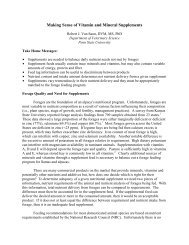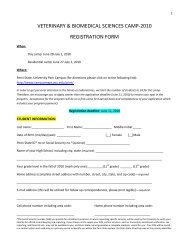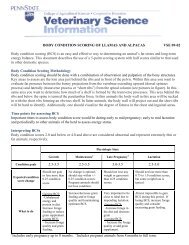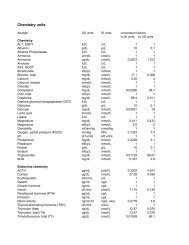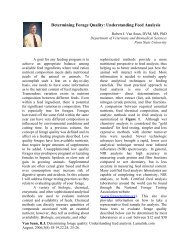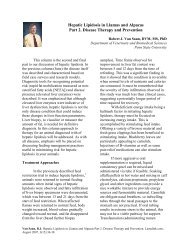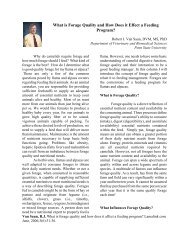Urinary Blockage in Llamas and Alpacas - Veterinary and ...
Urinary Blockage in Llamas and Alpacas - Veterinary and ...
Urinary Blockage in Llamas and Alpacas - Veterinary and ...
Create successful ePaper yourself
Turn your PDF publications into a flip-book with our unique Google optimized e-Paper software.
vitam<strong>in</strong> A deficiency have been implicated<br />
<strong>in</strong> predispos<strong>in</strong>g to urolithiasis. Reduced<br />
water <strong>in</strong>take can result <strong>in</strong> decreased flush<strong>in</strong>g<br />
action <strong>in</strong> the kidney tubules <strong>and</strong> <strong>in</strong>duce<br />
supersaturation of soluble m<strong>in</strong>erals thus<br />
caus<strong>in</strong>g their precipitation. Vitam<strong>in</strong> A<br />
deficiency can result <strong>in</strong> changes to the<br />
epithelial cells of the ur<strong>in</strong>ary tract <strong>and</strong> cause<br />
slough<strong>in</strong>g of cells becom<strong>in</strong>g a nidus for<br />
m<strong>in</strong>eral crystallization. Alkal<strong>in</strong>e ur<strong>in</strong>ary pH,<br />
often result<strong>in</strong>g from consumption of plants<br />
high <strong>in</strong> potassium, is associated with<br />
formation of calcium phosphate <strong>and</strong> struvite<br />
uroliths. Slightly acidic to neutral ur<strong>in</strong>ary<br />
pH is associated with silicate <strong>and</strong> calcium<br />
oxalate uroliths. Although not a common<br />
disorder <strong>in</strong> llamas <strong>and</strong> alpacas, silicate <strong>and</strong><br />
struvite crystals have been reported (Kock<br />
<strong>and</strong> Fowler, 1982; K<strong>in</strong>gston <strong>and</strong> Stäempfli,<br />
1995).<br />
Little is known about how<br />
urolithiasis occurs <strong>in</strong> llamas <strong>and</strong> alpacas <strong>and</strong><br />
it is assumed that the disease process is<br />
similar to other rum<strong>in</strong>ants. <strong>Llamas</strong> are noted<br />
for hav<strong>in</strong>g lower water <strong>in</strong>take per unit of<br />
metabolic body size <strong>and</strong> lower ur<strong>in</strong>ary<br />
output, which may naturally predispose<br />
them to ur<strong>in</strong>ary calculi. Other potential<br />
predispos<strong>in</strong>g factors <strong>in</strong>clude high alfalfa<br />
feed<strong>in</strong>g, excessive gra<strong>in</strong> <strong>in</strong>take <strong>and</strong><br />
<strong>in</strong>appropriate dietary calcium to phosphorus<br />
ratio. Alfalfa conta<strong>in</strong>s soluble oxalates <strong>and</strong><br />
high concentration of calcium. Excessive<br />
gra<strong>in</strong> feed<strong>in</strong>g can result <strong>in</strong> low dietary<br />
calcium to phosphorus ratio. A number of<br />
weedy or browse plants (Rumex spp., sorrels<br />
<strong>and</strong> dock) conta<strong>in</strong> large amounts of soluble<br />
oxalates that when consumed <strong>in</strong> excess<br />
under the right conditions may result <strong>in</strong><br />
oxalate urolith formation. Mature range<br />
grasses may conta<strong>in</strong> large amounts of<br />
oxalates <strong>and</strong> silicates, which can potentially<br />
contribute to urolith formation. One can<br />
measure acid <strong>in</strong>soluble ash content <strong>in</strong> an<br />
effort to estimate silica content of forages.<br />
Based on these observations, there does not<br />
seem to be any significant factor <strong>in</strong><br />
commercial llama feeds that would suggest<br />
they predispose consum<strong>in</strong>g animals to<br />
urolithiasis. This is not to say that<br />
<strong>in</strong>appropriate consumption of some<br />
commercial products may result <strong>in</strong> altered<br />
dietary nutrient content consistent with some<br />
of the predispos<strong>in</strong>g factors identified.<br />
Nutritional alterations are the<br />
primary concern <strong>and</strong> focus of prevention.<br />
Goals of a dietary prevention program are to<br />
<strong>in</strong>crease water consumption with addition of<br />
salt to the diet <strong>and</strong> ma<strong>in</strong>ta<strong>in</strong> appropriate<br />
amounts of calcium <strong>and</strong> phosphorus <strong>in</strong> the<br />
diet with a calcium-to-phosphorus ratio<br />
between 2-to-4:1. On the other h<strong>and</strong>,<br />
excessive calcium <strong>in</strong>take should be avoided.<br />
Excessive vitam<strong>in</strong> D <strong>in</strong>take could potentially<br />
lead to hypercalcemia or hypercalcuria <strong>and</strong><br />
predispose to calcium urolith formation.<br />
Excessive supplementation of prote<strong>in</strong> <strong>and</strong><br />
magnesium should also be avoided. These<br />
po<strong>in</strong>ts emphasize the need to provide a<br />
properly balanced diet, but no nutrient <strong>in</strong><br />
excess. This challenges us to better<br />
characterize actual nutrient requirements for<br />
llamas <strong>and</strong> alpacas. A new National<br />
Research Council (NRC) report has been<br />
recently published describ<strong>in</strong>g nutrient<br />
requirements for llamas <strong>and</strong> alpacas, but that<br />
is a topic for another column.<br />
Struvite crystals can be prevented by<br />
dietary modification to <strong>in</strong>duce ur<strong>in</strong>e<br />
acidification <strong>in</strong> dogs, cats, sheep <strong>and</strong> goats.<br />
Traditionally, dietary supplementation (5-10<br />
g/kg of dry matter) of ammonium chloride<br />
has been used. More palatable commercial<br />
products capable of acidification are<br />
available as they are commonly used <strong>in</strong><br />
dairy cattle rations prior to calv<strong>in</strong>g to<br />
prevent milk fever. However, little data are<br />
available to validate the efficacy <strong>and</strong> safety<br />
of prolonged feed<strong>in</strong>g of such products to<br />
llamas <strong>and</strong> alpacas. Given the predilection<br />
for oxalate <strong>and</strong> silicate uroliths <strong>in</strong> acidic pH,<br />
rout<strong>in</strong>e ur<strong>in</strong>ary acidification to prevent<br />
Van Saun, R.J. <strong>Ur<strong>in</strong>ary</strong> blockage <strong>in</strong> llamas <strong>and</strong> alpacas. Lamal<strong>in</strong>k.com, April 2007;3(8):30-31.





